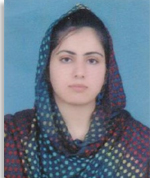|
PUBLICATIONS:
Articles:
Faculty members are actively involved in various research projects, and have honour to publish their research work in various reputed international journals with high impact factor.
• Javaid A, Anjum T, Bajwa R (2002). EM and VAM Technology in Pakistan. XII: Growth, nodulation and VA Mycorrhizal response of Phaseolus vulgaris L to Long-Term EM Application. Pakistan Journal of Phytopathology 14(1): 57-61.
• Bajwa R, Javaid A, Javaid A (2002). Effect of soil sterilization, organic Amendments and EM application on growth, yield and VA mycorrhizal colonization in maize. Pakistan Journal of Phytopathology 14(1): 62-67.
• Javaid A, Bajwa R (2002). EM and VAM technology in Pakistan XIII: growth, nodulation and mycorrhizal Colonization in Pea (Pisum sativum L.) in Soils with different histories of EM application. Pakistan Journal of Phytopathology 14 (2):120-124.
• Mahmood TZ, Shabbir A (2002) Allelopathic effects of Cyperus rotundus L. (purple
nutsedge on initial growth of Sugarcane. Indus Journal of Plant Sciences 1 (3): 263-265
• Bajwa R, Aslam N, Javaid A (2002). Comparison of three green manures for growth and vesicular arbuscular mycorrhizal (VAM) colonization in maize (Zea mays L.). Online Journal of Biological Sciences 2(8): 512-517.
• Bajwa R, Javaid A, Shah MBM (2003). Extent of Shisham (Dalbergia sissoo Roxb.)
Decline in Sialkot , Gujranwala , Lahore and Sargodha districts. Mycopath 1(1): 1-6.
• Javaid A, Bajwa R, Shah MBM (2003). Dieback resistance potential in different varieties of Dalbergia sissoo Roxb. Mycopath, 1 (2):105-110.
• Bajwa R, Javaid A, Mirza JH, Akhtar N (2003). Chemical control of wilt in Shisham
(Dalbergia sissoo Roxb.) Mycopath 1 (2), 111 -113.
• Bajwa R, Akhtar N, Javaid A (2003). Role of VAM in Alleviating allelopathic stress of Parthenium hysterophorus on maize (Zea mays L.) Growth. Mycopath, 1(1): 15-30.
• Nasim G, Bajwa R (2003). Endogonaceous spore flora of Pakistan. IX. Frequency of occurrence of VAM fungi in wheat fields around Punjab University Campus area.
Mycopath, 1(1): 67-80.
• Nasim G, M Din, S Ali, A Shabbir and MB Ilyas (2003). Effect of foliar application of
Ascochyta rabiei on growth and vesicular arbuscular mycorrhizal status of eight chick pea varieties, Mycopath 1(1): 85-94.
• Nasim G, N Ilyas and A Shabbir (2003). Effect of salts of copper on invitro growth of some soil fungi. Mycopath, 1(2): 155-158.
• Nasim G, Din Mali S , Shabbir A, Ilyas MB (2003). Study of dynamics of Phylloplane fungi in relation to Ascochyta blight in chick pea, Mycopath, 1(2): 179-183.
• Ahmed S (2003) Effects of NaCl salinity on germination and establishment of greengram seedlings. Biologia. 49 (1&2): 1-7.
• Ahmed S (2003) Some Toxicity symptoms of sodium chloride in mungbean. Biologia, 49 (1&2): 29-36.
• Wahid A, Ahmad S (2003). Environmental pollution and its effects on chilli (Capsicum annuum L.) grown in fields of Lahore. Biologia 49(1 &2) : 117-123.
• Bajwa R, Shafique S , Shafique S, Javaid A (2004). Effect of foliar spray of aqueous extract of Parthenium hysterophorus on growth of sunflower. International Journal of Agriculture & Biology 6(3): 474-478.
• Nasim G, Iqbal, SH, Mirza, JH, Riaz T, Butt S, Anjum, T and Shabbir, A., (2004). A brief note of Lichens from Swat, Mycopath 2(2), 79-82.
• Nasim G, Rahman M, Shabbir A (2004). Effect of Indole acetic acid on in vitro growth and Biomass Production of some Soil Fungi. Pakistan Journal of Biological Sciences 7 (12): 2039-2044.
• Nasim G, Rahman M , Shabbir A, Cheema,TS (2004). Effect of Gibberrellin on in vitro growth and Biomass Production of some Soil Fungi. Mycopath,2 (1): 15-19.
• Nasim G, Abbas G, Shah BM (2004). Seasonal variation of AM fungal colonization in Sugarcane (Saccharum officinarum L.) plants suffering from ratta Roag (red rot) disease. Mycopath m2 (1): 37-42.
• Bashir K, Husnain T, Fatima T, Latif Z , Mehdi SA, Riazuddin S (2004). Field
evaluation and risk assessment of transgenic indica Basmati rice. Molecular Breeding 13: 301-312.
• Bajwa R, Mukhtar I, Anjum T (2004). Invitro biological control of Fusarium solani - cause of wilt in Debergia sissoo Roxb. Mycopath. 2(1): 11-14.
• Javaid A, Bajwa R, Anjum T (2004). Tree dieback in Punjab, Pakistan. Mycopath 2(1): 1- 5.
• Javaid A, Bajwa R Anjum T (2004). Identification of some more varieties of Shisham (Dalbergia sissoo Roxb.) and their response to dieback and wilt. Mycopath, 2(2):55-59.
• Wahid, A. and Ahmad, S. (2004). Growth and biochemical status of wheat seedlings treated with industrial effluents. Biologia 50 (1) : 1-7.
• Anjum T, Bajwa R (2005). A bioactive annuionone from sunflower leaves. Phytochemistry,
66: 1919-1921.
• Hafeez FY, Naeem FI, Naeem R, Zaidi AH, Malik KA (2005). symbiotic effectiveness
and bacteriocin production of Rhizobium leguminosarum biovar viciae isolated from
agriculture soils in Faisalabad . Environmental and Experimental Botany 54, 142-147.
• Hafeez, FY, Naeem FI, Shaheen N, Malik KA (2005). Nodulation of sesbania spp. By
introduced rhizobia in competition with naturalized strains in different soil types. Pakistan Journal of Botany (Accepted)
• Bajwa R, Naz I (2005). Allelopathic effects of Eucalyptus citriodora on growth, nodulation and AM colonization of Vigna radiata (L.) Wilczek. Allelopathy Journal 15(2): 237-246.
• Bajwa R (2005). Interaction of AM fungi with allelochemicals. Allelopathy Journal 15(2):
• Nasreen, Z., KausarT., Nadeem M, Bajwa R.(2005). Study of different growth parameters in Ganoderma lucidum. Micologia Aplicada International 17(1): 5-8.
• Bajwa R (2005). Effects of arbuscular mycorrhizae (AM) and effective microorganisms (EM) on various plants under allelopathic stress. Allelopathy Journal 16(2): 261-272.
• Ahmed S, Wahid A, Rasul E, Wahid A, (2005). Comparative morphological and
physiological responses of greengram genotypes to salinity applied at various growth
stages. Bot. Bull Acad. Sin., 46: 135-14215
• Anjum T, Bajwa R, Javaid A, (2005). Biological Control of Parthenium I: Effect of Imperata cylindrica on distribution, germination and seedling growth of Parthenium hysterophorus L. International Journal of Agriculture and Biology 7(3): 448-450.
• Anjum T, Javaid A, (2005). Major diseases of citrus in Pakistan - a review. International Journal of Biology and Biotechnology 2(4): 793-796.
• Anjum T, Bajwa R (2005). Importance of Germination Indices in interpretation of
allelochemical effect on seed germination. International Journal of Agriculture & Biology 7(3): 417-419.
• Bajwa R, Iftikhar S (2005). Antifungal activity of allelopathic plant extracts. VI. In vitro control of fungal pathogens by aqueous leaf extracts of Eucalyptus. Mycopath, 3(1 &2): 7- 12.
• Javaid A, Anjum T (2005). Parthenium hysterophorus L. - A noxious alien weed. Pakistan Journal of Weed Science Research 11 (3-4): 171 -177.
• Javaid A, Anjum T (2005). Wheat and rice diseases in Pakistan and their management - a review. International Journal of Biology and Biotechnology 2(4): 785-791.
• Javaid A, Bajwa R, Javaid A, Anjum T (2005). Fungi associated with seeds of pulses collected from Lahore and their effect on seed germination. Mycopath 3(1 &2): 12-15.
• Javaid A, Bajwa R, Anjum T (2005). Biological Control of Parthenium II: Allelopathic effect of Desmostachya bipinnata on distribution and early seedling growth of Parthenium hysterophorus L. International Journal of Biology and Biotechnology 2(2): 459-463.
• Javaid A, Bajwa R, Javaid A (2005). Decline of Erythrina suberosa Roxb. in
Punjab , Pakistan . Pakistan Journal of Phytopathology 17(2): 105-107.
• Javaid A (2005). Mango (Mangifera indica L.) diseases in Pakistan and their management -a review. Pakistan Journal of Phytopathology M (2): 108-112.
• Nasim, G, (2005). Role of symbiotic soil fungi in controlling roadside erosion and in the establishment of plant communities. Caderno Pesquisa Serie Biologia, 17(1), 119-136
• Nasim, G and Bajwa, R. (2005). Glomalean spores associated with major cereals I-Wheat Caderno Pesquisa Serie Biologia, 17(1), 137-154.
• Nasim G, Ilyas N, Shabbir A (2005). Effect of some organic pesticides on in vitro growth of some soil fungi. Journal of Environment, Mycopath, 3 (1 &2).
• Nadeem M, Rani Z, Aman S Kazmi AM, Shabbir A (2005). Parthenium weed: a growing concern in Pakistan. Journal of Pakistan Association of Dermatologists 15(1) pp 4-8.
• Shabbir A, Bajwa R (2005). Senna occidentalis: a native plant to restore the natural vegetation of Islamabad World conference on ecological restoration - A Global Challenge held from 12-18 September Zaragoza, Spain Europe.
• Shafique S, Shafique S, Javaid A (2005). Fungitoxicity of aqueous extracts of allelopathic plants on seed-borne mycoflora of maize. Mycopath 3(1 &2): 22-25.
• Shafique S, Javaid A, Bajwa R, Shafique S (2005). Biological Control of Parthenium IV: Suppressive ability of aqueous leaf extracts of some allelopathic trees against germination and early seedling growth of Parthenium hysterophorus L. Pakistan Journal of Weed Science Research 11(1-2): 75-79.
• Shad N., Mughal S.M. and Bashir M. (2005). Transmission of Mungbean yellow mosaic begono virus (MYMV). Pak. Journal of Phytopathology 2(17): 141-143.
• Anjum T, Javaid A, Shah MBM (2006). Correlation between plant growth and arbuscular mycorrhizal colonization in some rainy season grasses. Pakistan Journal of Botany 38 (3): 841-847.
• Anjum T, Bajwa R (2006). Field appraisal of herbicide potential of sunflower leaf extract against Rumex dentatus. Field crops research. (in press)
• Bajwa R, Anjum T, Shafique S. and Shafique, S., (2006). Evaluation of antifungal activity of Cicer arietinum L. Pakistan Journal of Botany 38(1): 175-184.
• Bajwa R, Javaid A (2006). Integrated management to control shisham (Dalbergia sissoo Roxb.) decline in Pakistan. Pakistan Journal of Botany, 38 (Special Issue): in press
• Javaid A, Anjum T (2006). Control of Parthenium hysterophors uL. by aqueous extracts of allelopathic grasses. Pakistan Journal of Botany 38 (1): 139-145.
• Javaid A, Bajwa R, Anjum T (2006). Response of black gram [Vigna mungo (L) Hepper] to bradyrhizobium japonicum inoculation under different soil amendment systems. Pakistan Journal of Botany 38 (3): 849-855
• Javaid A, Shafique S, Bajwa R, Shafique S (2006). Effect of aqueous extracts of
allelopathic crops on germination and growth of Parthenium hysterophorus L South African Journal of Botany 72(4): 608-611
• Javaid A (2006). Foliar application of effective microorganisms on pea as an alternative fertilizer. Agronomy for Sustainable Agriculture 26(4): (in press)
• Javaid A, Shafique S, Shafique S (2006). Causes of rapid spread of Parthenium
hysterophorus L. in pakistan and possible control measures - a review. Pakistan Journal of Botany, 38 (Special Issue) in press
• Shad N., Mughal S.M., Farooq K., and Bashir M., (2006). Evaluation of Mungbeen germ plasm for resistance against Mungbean yellow MOSAIC Begomovirus. Pakistan Journal of Botany 38(2): 449-457.
• Mehnaz S, Lazarovits G (2006). Inoculation effects of Pseudomonas putida.
(iluconacelobacter azotocaptans and Azospirillum lipoferum on corn plant growth under green house conditions. Microbial Ecology, 51: 326-35.
• Mehnaz S, Wesclowski B, Lazarovits G (2006). Isolation of Glucomacetobacter
azotocaptans from corn rhizosphere. Systematic and Applied Microbiology (Inpress:
Available online)
• Mirza MS, Mehnaz S, Normand P, Prigent-Combaret C, Moenne-Loccoz Y, Bally R, Malik K.A (2006). Molecular characterization and PCR-detection of a nitrogen fixing
Pseudomonas strain promoting rice growth. Biology and Fertility of Soil (in Press: available online)
• Nasim G, (2006) Mountain mycorrhizal biodiversity in the northern Pakistan-yesterday, today and tomorrow.141-143 In: Global Change in the Mountain Rregions . Editor: Martin F. Price, Sapiens Publishing, Duncow, Kirkmahoe, Drumfrieshire, DG1, 1TK, UK.
• Shabbir A, Bajwa R (2006). Distribution of Parthenium weed (Parthenium hysterophorus) I: an alien invasive weed species threatening the biodiversity of Islamabad . Weed Biology and Management (In Press).
• Shafique S, Javaid A, Bajwa R, S Shafique (2006). Effect of aqueous leaf extracts of allelopathic trees on germination and seed-borne mycoflora of wheat Pakistan Journal of Botany, 38 (Special Issue): in press
• Shafique S, Bajwa R, Javaid A, Shafique S (2006). Biological control of Achyranthes aspera and Xanthium strumarium in Pakistan. Pakistan Journal of Botany, 38 (Special Issue): in press
70. Bajwa R, Shafique S, Shafique S (2006). Effect of leaf rust infection on ycorrhizal
colonization ofweeds. Mycopath 4(1): 1-4.
• Javaid A, Anjum T, Bajwa R, (2006). Chemical control of noxious weed Parthenium
hysterophorus L. International Journal of Biology and Biotechnology 3(2): 387-390.
• Javaid A Shabir A, Nawaz S (2006). Preliminary report on tree dieback in Balochistan. International Journal of Biology and Biotechnology 3 (4): (in press)
• Javaid A, Shafique S, Bajwa R, Shafique S (2006). Biological control of noxious alien weed Parthenium hysterophorus L. in Pakistan. International Journal of Biology and Biotechnology 3 (4): (in press)
• Javaid A, Shafique S and Shafique S (2006). Fungi associated with stored seeds of
Parthenium hysterophorus collected from Lahore. International Journal of Biology and Biotechnology 3(3):551 -553.
• Javaid A, Shafique S and Shafique S (2006). Parthenium weed - an emerging threat to plant biodiversity in Pakistan. International Journal of Biology and Biotechnology 3(3): 619- 622.
• Javaid A, Shabir A, Bajwa R (2006). First report of biological control of Parthenium
hysterophorus by Zygogramma bicolorata in Pakistan. Pakistan Journal of Phytopathology 18(1): (in press)
• Javaid A, Akhtar N (2006). Acacia nilotica (babul or kikar) dieback in Punjab, Pakistan. Pakistan Journal of Phytopathology 18(1): 1-4.
• Javaid A, Bajwa R, Shafique S, Shafique S (2006). Tree dieback incidence in Nathiagali and surrounding hills. International Journal of Biology and Biotechnology 3 (1): 73-75.
• Javaid A, Anjum T (2006). Fungi associated with seeds of economically important crops in Pakistan. Pakistan Journal of Seed Technology (in press)
• Javaid A, Anjum T, Shah MBM (2006). Correlation of arbuscular mycorrhizal colonization with plant growth, nodulation, and shoot NPK in legumes Pakistan Journal of Phytopathology 18(1): (in press)
• Mukhtar I, Bajwa R, Ashraf A, Javaid A, Shah MBM (2006). Complimentary effect of Trichoderma harzianum and some allelopathic plant extracts on Fusarium solani.
International Journal of Biology and Biotechnology 3 (1): 77-80.
• Nasim G 2006 Glomalean Spore Flora of Pakistan. III. Spores formed freely in soil
aggregates. International Journal of Agriculture and Biotechnology. 3(3), 555-560.
• Shafique S, Bajwa R, Javaid A, Shafique S (2006). Antifungal activity of aqueous extracts of weeds against pathogen of black pointed disease of wheat seeds. Pakistan Journal of Phytopathology 18(1): 5-8.
• Shah MBM, Bajwa R and Javaid A (2006). Response of maize (Zea mays L.) genotypes to inoculation of two arbuscular mycorrhizal species. Int. J. Biol. Biotechnol., 3(1): 191-196.
• Sohail MI, Rao SA, Javaid A (2006). Evaluation of hybrid corn (Zea mays L.). International Journal of Biology and Biotechnology 3 (2): 391-397.
• Anjum, T. and Bajwa, R. (2007). Field appraisal of herbicide potential of sunflower leaf extract against Rumex dentatus . Field Crops Res., 100 :139-142.
• Javaid, A., Bajwa, R., Rabbani, N. and Anjum, T. (2007). Comparative tolerance of six rice genotypes to allelopathy of purple nutsedge ( Cyperus rotundus L.). Allelopathy Journal, 20 (1):157-166.
• Nasreen, Z., Bajwa, R., Kausar, T. and Baig, S. (2007). Bistage control of pH, temperature & agitation speed for improving mycelilal growth of edible and medicinal mushrooms in shake flask culture. Pakistan J. Biochem. Mol. Biol ., 40 (1):15-22.
• Bajwa, R. and Mukhtar, I. (2007). Incidence of Shisham dieback disease in different agro-ecological zones of the Punjab. Proceedings of Third National Seminar on “Shisham Dieback”, May 11, 2006, at Punjab Forestry Research Institute, Faisalabad.
• Javaid, A., Bajwa, R., Rabbani, N. and Anjum, T. (2007). Comparative tolerance of rice ( Oryza sativa L.) genotypes to purple nutsedge ( Cyperus rotundus L.) allelopathy. Allelopathy Journal ,
20 (1):157-166.
• Bajwa, R., Javaid A. and Riaz, T. (2007). Correlation between plant growth mycorrhizal colonization in mungbean under allelopathic stress. Pakistan J. Phytopathol., 19 (1):47-53.
• Bajwa, R. (2008). Mass production of Alternaria alternata isolates: Bioherbicide agents for Rumex dentatus and Chenopodium album. Phytopathology, 98 (6):S17-S17.
The first author(s) of the articles conducted research as Ph.D./M.Phil. students under the supervision of Prof. Dr. Rukhsana Bajwa.
• Nasim, G., Bajwa, R. and Hakeem, A. (2007). Response of arbuscular mycorrhizal mungbean plants to ambient air pollution. International Journal of Environmental Science and Technology ,
4 (3):295-310.
• Nasim, G., Bajwa, R. and Hakeem, A. (2007). Response of arbuscular mycorrhizal fungi and Bradyrhizobium japonicum to air pollution stress in Soybean. Journal of Agricultural and Biological Sciences, 2 (3):23-46.
• Nasim, G. and Bajwa, R. (2008). Seasonal dynamics and relative abundance of AM fungi in rhizosphere of rice ( Oryza sativa L. cv. Basmati Supper). Mycopath , 5 (1): 53-64.
• Suliman, R., Bajwa, R. and Nasim, G. (2007). Qualitative assessment of drinking water in New Campus, Punjab University, Lahore. Pakistan. International Journal of Biology and Biochemistry ,
4 (2-3):219-222.
• Augé, R.M. , Toler, H.D., Sams, C.E. and Nasim, G. . (2008). Hydraulic conductance and water potential gradients in squash leaves showing mycorrhiza induced increases in stomatal conductance. Mycorrhiza, 18 :115-121.
• Nasim, G. and Bajwa, R. (2008). Arbuscular mycorrhizal symbiosis of wheat and exposure to air pollutants in urban Pakistan, Canadian Journal of Pure and Applied Sciences, 2 (1):155-174.
• Nasim, G. Ilyas, N., Ali A. and Munawer, A. (2008). Effect of Salt priming on in vitro growth of some soil fungi. Pakistan Journal of Botany , 40 (1):427-431.
• Nasim, G. (2008). Influence of rice allelopathy on sporocarp formation by Glomus monosporum in leaf sheath bases of wheat. Allelopathy Journal , 22 (2)-403-408.
• Nasim, G. and Bajwa, R. (2008). Why do arbuscular mycorrhizal fungi form hyphal platoons? Phytopathology , 98 (6):112.
• *Nazir, N., Mirza, J.H., Akhtar, N., Bajwa, R. and Nasim, G. (2007). Some studies on thermophilic and thermotolerant fungi from Lahore, Pakistan. Mycopath, 5 (2):95-100.
• Nasim, G., Bajwa, R. and Ali, M. (2007). Sparassis crispa (Wulf.) Fr., The Cauliflower mushroom- A new record from Lahore, Pakistan. Mycopath , 5 (2):119-120.
• Nasim, G., Bajwa, R. and Mohammad, A. (2007). Urdu translation of Executive summary of an IGBP (International Geosphere Biosphere Program) Product Entitled “Global Change and the Earth system-A planet Under Pressure”. Published by Pakistan Academy of Sciences.
• Nasim, G., Ali, A., Munawar, A. and Bajwa, R. (2008). Seasonal dynamics of AM fungi in sugarcane ( Saccharum officinarum L. cv. SPF-213) in Punjab, Pakistan. Pakistan Journal of Botany ,
40 (6):2587-2600.
• Nasim, G. (2008). The medicinally important resources of our mountainous regions threatened?-Throwing light on the dark side of the story, in the proceedings of 1st International Seminar on Medicinal Plants, Isolation and Applications (ISMP-2008). May 21-23, Jointly Organized by Department of Chemistry (Organic Section), Lahore College for Women University and British Council, Lahore, Pakistan, 153-165.
• Nasim, G. (2008). Role of gene manipulation in the development of arbuscular mycorrhizal (AM) biofertilizer inoculum for economically important plants. In the proceedings of 1st International Seminar on Medicinal Plants, Isolation and Applications (ISMP-2008). May 21-23, Jointly Organized by Department of Chemistry (Organic Section), Lahore College for Women University and British Council, Lahore, Pakistan, 197-207.
• Nasim, G., Bajwa, R. and Mohammad, A. (2008). Urdu Translation of IGBP Report 55: International Geosphere Biosphere Program, Science Plan and implementation Strategy, Published by IGBP Secretariat, Stockholm, Sweden (Acceptance/permission letter is received for translation). Jointly published by Environment Protection Department, Govt. of the Punjab, and the Department of Urdu Taleef-o-Tarjuma, University of the Punjab, Lahore.
The first author(s) of the articles conducted research as Ph.D./M.Phil. students under the supervision of Dr. Ghazala Nasim.
• Riaz, T., Khan, S.N. and Javaid, A. (2007). Effects of incorporation of allelopathic plants leaf residues on mycorrhizal colonization and Gladiolus diseases. Allelopathy Journal , 20 (1):61-70.
• Mahmood, M., Khan, S.N., Ali, S. and Alam, S. (2007). Methods for the chemical control of quick decline/ sudden death of Mango. Pakistan Journal of Phytopathology , 19 (1):81-85.
• *Mahmood, M., Khan, S.N., Ali, S. and Khan, S.M. (2007). Survey for prevalence of sudden death of mango in different districts of Punjab. Pakistan Journal of Phytopathology , 19 (1):86-89.
• Khan, S.N., Ayub, N. and Ahmad, I. (2007). Inhibitory effect of extracts of plant parts of sunflower hybrids on sclerotia production of Macrophomina . Pakistan Journal of Phytopathology , 19 (2):150-154.
• Khan, S.N., Ayub, N. and Ahmad, I. (2007). Effect of inoculum density of Macrophomina phaseolina on severity of charcoal rot on sunflower. Pakistan Journal of Phytopathology , 19 (2):155-159.
• Mahmood, M., Khan, S.N., Ali, S. and Khan, S.M. (2007). Physiological studies of Lasiodiplodia theobromae the cause of quick decline of mango . Pakistan Journal of Phytopathology, 19 (2):160-162.
• Mahmood, M., Khan, S.N., Ali, S. and Ahmad, I. (2007). Screening of genetic source against death/quick decline of Lasiodiplodia theobromae of mango. Pakistan Journal of Phytopathology , 19 (2):163-165.
The first author(s) of the articles conducted research as Ph.D./M.Phil. students under the supervision of Dr. Salik Nawaz Khan.
• Riaz, T., Khan, S.N. and Javaid, A. (2007). Scenario of gladiolus production in Punjab, Pakistan. Pakistan Journal of Botany, 39 (7):2389-2393.
• Shafique, S., Javaid, A. , Bajwa, R. and Shafique, S. (2007). Biological control of Achyranthes aspera and X anthium strumarium in Pakistan. Pakistan Journal of Botany, 39 (7):2607-2610 .
• Javaid, A., Shafique, S. and Shafique, S. (2007). Causes of rapid spread of Parthenium hysterophorus L. in Pakistan and possible control measures – a review . Pakistan Journal of Botany, 39 (7):2611-2618.
• *Shafique, S., Javaid, A., Bajwa, R. and Shafique, S. (2007). Effect of aqueous leaf extracts of allelopathic trees on germination and seed-borne mycoflora of wheat Pakistan Journal of Botany, 39 (7):2619-2624.
• Javaid, A., Jabeen, K. and Javaid, A. (2007). Effect of NPK fertilizers and two types of green manures on growth and mycorrhizal colonization of wheat. Pakistan Journal of Phytopathology, 19 (2):132-138.
• Riaz, T., Javaid, A. and Sheik, N.A. (2007). Response of sunflower to Glomus epigaeum and G. pubescens inoculation . Pakistan Journal of Phytopathology, 19 (2):145-149.
• Riaz, T., Javaid, A. and Sheik, N.A. (2007). Effect of co-cultivation and residue incorporation of Parthenium hysterophorus on plant growth and corm dry rot of Gladiolus. Pakistan Journal of Phytopathology, 19 (2):155-159.
• Javaid, A. and Riaz, T. (2007). Spread of aggressive alien weed Parthenium hysterophorus L. in district Okara, Pakistan . Journal of Animal and Plant Sciences, 17 :59-62.
• Javaid, A., Riaz, T. and Khan, S.N. (2007). Mycorrhizal status of Narcissus papyraceus Ker-Gawl. co-cultivated with Cynodon dactylon Pers. International Journal of Agriculture and Biology, 9 (6):901-904
• Javaid, A. and Shah, M.B.M. (2007). Phytotoxic effects of aqueous leaf extracts of two Eucalyptus spp. against Parthenium hysterophorus L. Science International (Lahore), 19 (4):303-306.
• Habib, S., Shad, N. and Javaid, A. (2007). Screening of mungbean germplasm for resistance/tolerance against yellow mosaic disease. Mycopath, 5 (2):89-94
• Ashraf, H. and Javaid, A. (2007). Antifungal activity of Meliaceae family against Macrophomina phaseolina – the cause of charcoal rot disease of sunflower Mycopath, 5 (2):81-84.
• Jabeen, K. and Javaid, A. (2008). Antifungal activity of aqueous and organic solvent extracts of allelopathic trees against Ascochyta rabiei . Allelopathy Journal, 22 (1):231-238.
• Javaid, A. (2008). Allelopathy in mycorrhizal symbiosis in the Poaceae family . Allelopathy Journal, 21 (2):207-218.
• Javaid, A. and Riaz, T. (2008). Effects of application of leaf green manure of allelopathic plant s on growth and mycorrhizal colonization of maize Allelopathy Journal, 21 (2):339-348.
• Javaid, A., Bajwa, R. and Anjum, T. (2008). Effect of heat sterilization and EM (effective microorganisms) application of wheat ( Triticum aestivum L.) grown in organic matter amended soils. Cereal Research Communications, 36 (3):489-499.
• Javaid, A. and Riaz, T. (2008). Mycorrhizal colonization in different varieties of Gladiolus and its relation with plant vegetative and reproductive growth. International Journal of Agriculture and Biology, 10 (3):278-282.
• Javaid, A. (2008). Research on shisham ( Dalbergia sissoo roxb.) decline in Pakistan – a review. Pakistan Journal of Phytopathology, 20 (1):134-142.
• Jabeen, K., Javaid, A. and Athar, M. (2008). Fungistatic activity of aqueous and organic solvent extracts of Melia azedarach against Ascochyta rabiei. Pakistan Journal of Phytopathology, 20 (1):143-149.
• Idrees, H. and Javaid, A. (2008). Screening of some pathogenic fungi for their herbicidal potential against parthenium weed. Pakistan Journal of Phytopathology, 20 (1):150-155.
The first author(s) of the articles conducted research as Ph.D./M.Phil. students under the supervision of Dr. Arshad Javaid.
• Ahmed, S. (2007). The Growth and Development of mungbean under filtered and unfiltered air chambers. International Journal of Agriculture & Biology , 9 (5):688-692.
• Ahmed, S. (2007). Impact of air pollution on plant diseases – a review . Pakistan J. Phytopathology , 19 (2):140-146.
• Ahmed, S. (2007). Airborne fungal spores – a review . Pakistan J. Phytopathology , 19 (2):181-189.
• Anjum, T. and Bajwa, R.. (2007). The effect of sunflower leaf extracts on Chenopodium album in wheat fields in Pakistan . Crop Protection, 26 : 1390 – 94.
• Anjum, T. and Bajwa, R. (2007). Field appraisal of herbicide potential of sunflower leaf extract against Rumex dentatus. Field Crops Research, 100 (2-3):139 – 142.
• Anjum, T. and Bajwa, R. (2008). Screening of sunflower varieties for their herbicidal potential against common weeds of wheat. Journal of Sustainable Agriculture , 32 (2):213-229.
• Younas, M., Husnain, T., Anjum, T., Fakhar-un-Nisa and Riazuddin, S. (2008). Baseline susceptibility of red flour beetle to Bt toxins. Journal of Sustainable Agriuculture , 32 (1):181-190.
The first author(s) of the articles conducted research as M.Phil. student under the supervision of Dr. Tehmina Anjum.
• Habib, S., Shad, N., Javaid, A. and Iqbal, U. (2007). Screening of mungbean germplasm for resistance/ tolerance against yellow mosaic disease. Mycopath , 5 (2):89-94.
• Iqbal, U., Malik, S.R., Iqbal, S.M., Bakhsh, A. and Shad, N . (2008). Evaluation of chickpea germplasm for resistance to Ascochyta blight. Pakistan Journal of Phytopathology , 20 (2):218-221.
The first author(s) of the articles conducted research as M.Phil. student under the supervision of Mr. Nadeem Shad.
|




















